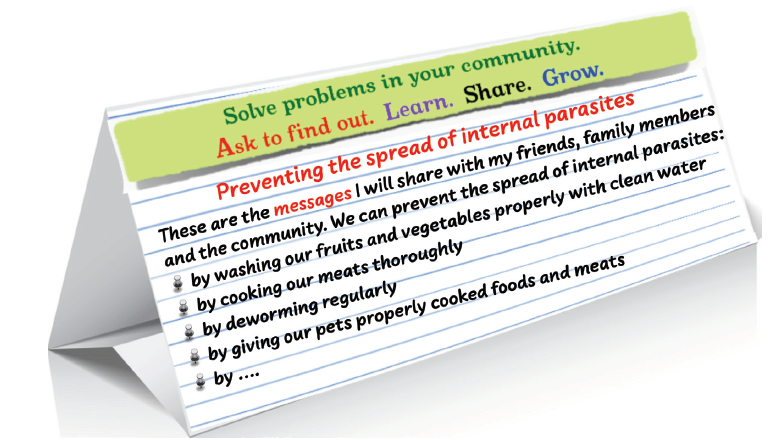Getting Ready: In our learning activities, we will:
- Discuss the signs, symptoms and prevention and management of the following internal parasites:
- Roundworms
- Pinworms
- Tapeworms
- Hookworms
- Find out more about ways of preventing the spread of internal parasites. We will share this information with others in our communities. In this way, we will develop interest in ensuring good health for ourselves, our families and our communities.
What we already know
From earlier studies in Environmental Activities, Home Science and Science and Technology, we already know that it is important to maintain hygiene in our living areas.
In what ways do we observe hygiene at home and in school? Discuss with a partner.
We also know that it is important to wash fruits well before eating. It is also important to wash hands before handling foods. Why is that important? Discuss it with a friend.
Activity 2.30: Learn new words
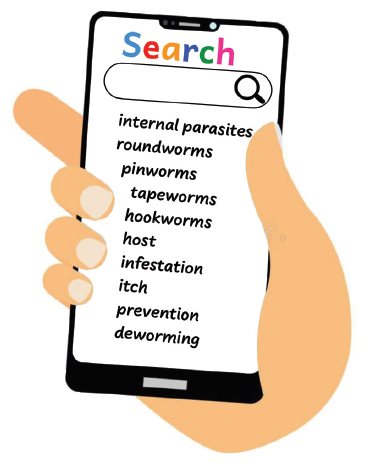
Activity 2.31: What causes internal parasites?
Work safely in groups. Discuss these questions:
- What worms do you know? How are these worms spread?
- How do they affect human beings?
- In which ways can we prevent their spread from one person to another?
Internal Parasites
Activity 2.32: What are internal body parasites?
Work safely in groups. Use the Internet to find out the following:
- What are internal body parasites?
- What are some examples of internal body parasites?
- Where are they found in the human body?
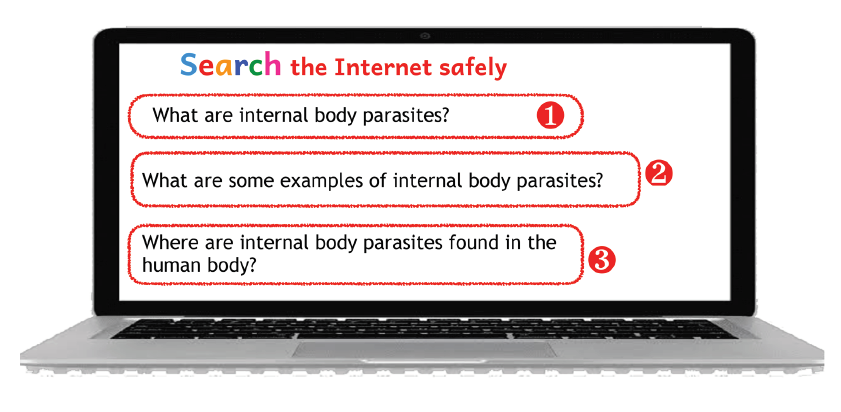
Learn more. Grow. Share the knowledge with your family and community members
- Parasites which live inside the body are known as internal parasites.
- The affected person is known as the host.
- Roundworms, tapeworms, pinworms and hookworms are examples of internal parasites.
- Internal parasites get food and shelter from the host.
- Parasites cause harm or even kill the host.
- Find out the types of internal parasites that affect people in your community.
Nr 1 is a .
Nr 2 is a .
Nr 3 is a .
Nr 4 is a .
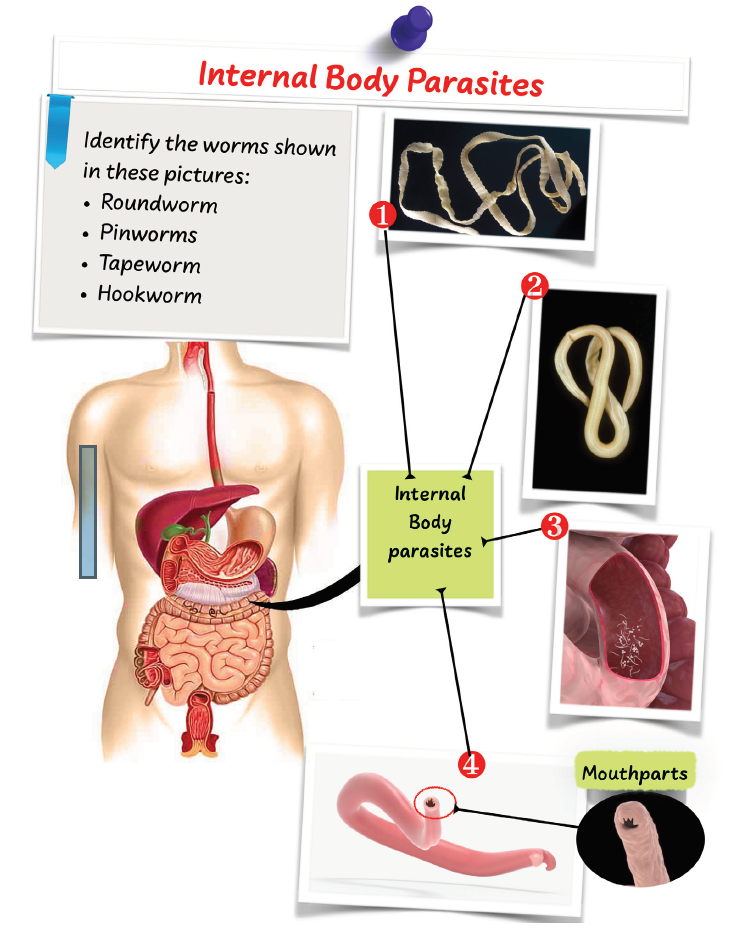
Roundworms
Activity 2.34: Let us find out more about roundworms
Use the Internet to find out the following:
- How are roundworms spread?
- What are the signs and symptoms of presence of roundworms?
- How can you protect yourself from roundworm infestation?
- What are the effects of roundworm infestation?
Learn more. Grow. Share the knowledge with your family and community members
- Roundworms are internal parasites.
- Their eggs are found in the soil.
- The eggs get into the body when we eat food with dirty hands that may have come into contact with the eggs of the worms.
- They also get into the body through eating raw vegetables, fruits or salads that may have the worm eggs.
- Children get worms when they touch soil and put their fingers in the mouth.
- Infestation of roundworms may be prevented by washing hands with soap and plenty of running water before eating and handling foods.
- It is also important to wash fruits and vegetables with clean water before use.
- Always drink boiled cooled water.
- Parents are advised to give medicine to children to kill any worms in the body regularly. This is known as deworming.

Pinworms
Activity 2.35: Let us find out more about pinworms
Work safely in groups. Use the Internet safely to find out the following:
- How are pinworms spread?
- What signs and symptoms indicate the presence of pinworms in the body?
- How can you protect yourself from pinworm infestation?
- What are the effects of pinworm infestation?
Learn more. Grow. Share the knowledge with your family and community members
Pinworms are internal parasites. They are also known as threadworms. They are the size of a staple pin, about a centimetre long. Their eggs are found in the soil. The eggs get into the body through eating with dirty fingers, and sharing underwear, bedding, towels, clothes with an infected person. Children also get infected through putting dirty toys in the mouth.
Pinworm infestation may be prevented in the following ways:
- Washing hands before eating.
- Keeping the fingernails short.
- Avoiding biting fingernails.
- Soaking clothes in hot water.
- Cleaning surfaces and toys with soap and water.
- Regular deworming.

Tapeworms
Activity 2.36: Let us find out more about tapeworms
Work safely in groups. Use the Internet safely to find out how tapeworms are spread. What are the signs and symptoms that indicate the presence of tapeworms? How can you protect yourself from tapeworm infestation? What are the effects of tapeworm infestation?
Learn more. Grow. Share the knowledge with your family and community members
- Tapeworms are internal parasites. Tapeworms are long and have many segments.
- The head of a tapeworm has parts called suckers.
- The suckers help the worm to attach itself to the walls of the intestine.
- Tapeworms get into the body through eating raw or undercooked meat and getting into contact with infected animal faeces.
Infestation from tapeworm may be prevented by:
- Eating inspected and properly cooked meats.
- Cleaning the chopping board with soap and water after cutting meat on it. It is advisable to have separate chopping boards for meats and vegetables.
- Treating and feeding pets with properly cooked meat.
- Regular deworming.
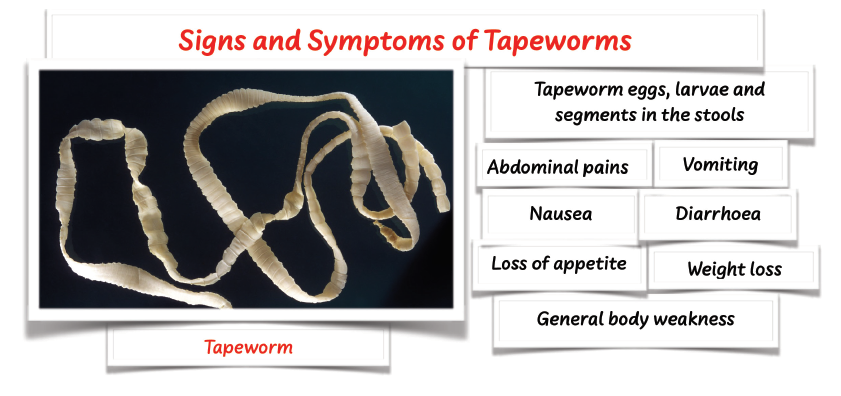
Hookworms
Activity 2.37: Let us find out more about hookworms
Work safely in groups. Use the Internet to find out the following:
- How are hookworms spread?
- What are the signs and symptoms of presence of hookworms?
- How can you protect yourself from hookworm infestation?
- What are the effects of hookworm infestation?
Learn more. Grow. Share the knowledge with your family and community members
Hookworms are internal parasites. They look like roundworms but have hooks on one end. Hookworms get into the body when one walks without shoes on contaminated soil. They could get into the body through contaminated vegetable salad and working in farms with contaminated soil.
Infestation from hookworms may be prevented in the following ways:
- Wearing shoes when walking on grounds suspected to be contaminated.
- Washing vegetable salads with clean water.
- Using toilets to prevent the spread of hookworms.
- Treating dogs and cats for hookworms and regular deworming.
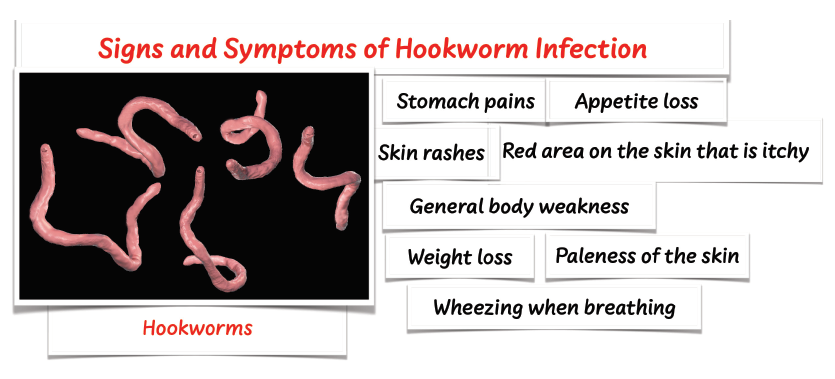
Summary
Involve your family. Serve your community. Ask to find out. Learn. Share. Grow. Solve problems.
Activity 2.38: Complete this activity
Work safely in groups. Draw and complete these charts. Show the charts to your family and community members.
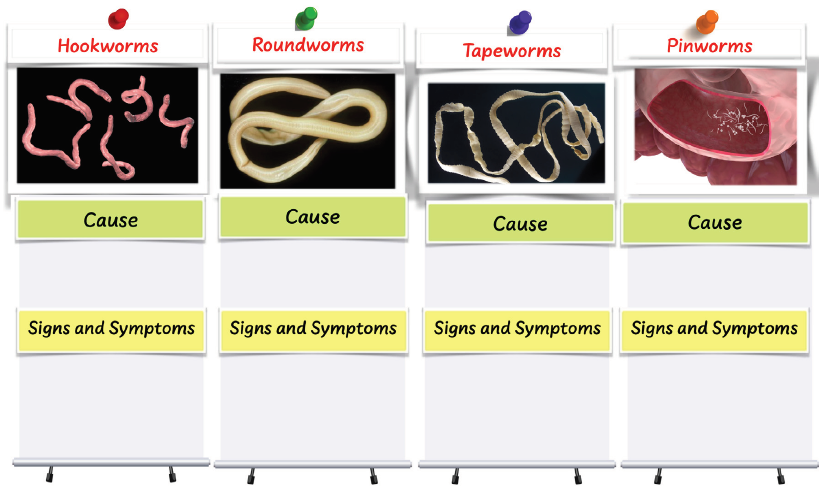
Write prevention messages that you will share with your community.
